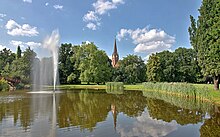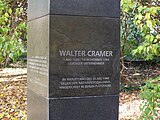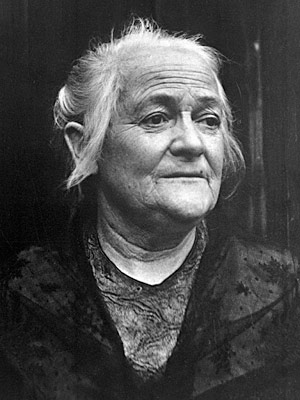
Clara Zetkin was a German Marxist theorist, communist activist, and advocate for women's rights.

Peter Joseph Lenné was a Prussian gardener and landscape architect. As director general of the Royal Prussian palaces and parks in Potsdam and Berlin, his work shaped the development of 19th-century German garden design in the Neoclassical style. Laid out according to the principles of the English landscape garden, his parks are now World Heritage Sites.

Markkleeberg is an affluent suburb of Leipzig, located in the Leipzig district of the Free State of Saxony, Germany. The river Pleiße runs through the city, which borders Leipzig to the north and to the west.
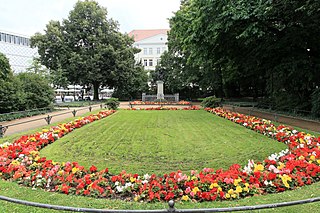
Goerdelerring is a street and major tram interchange station in Leipzig, Germany. It is named after Carl Friedrich Goerdeler.

Waldstraßenviertel, is a neighbourhood in the north west of Leipzig's borough Mitte in Saxony, Germany. It is considered one of the largest complete areas of Gründerzeit buildings in Europe and is therefore considered of important cultural and heritage status. Many of its buildings are therefore protected or listed.
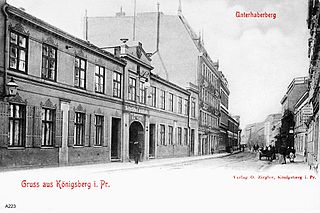
Haberberg was a mostly residential quarter of southern Königsberg, Germany. Its territory is now part of the Moskovsky District of Kaliningrad, Russia.
Neurossgarten was a quarter of northwestern Königsberg, Germany. Its territory is now part of Kaliningrad, Russia.
Nasser Garten or Nassengarten was a quarter of Königsberg, Germany, located southwest of the city center. Its territory is now part of the Moskovsky District of Kaliningrad, Russia.

The Palmengarten is a park in Leipzig-Lindenau. It covers a surface of 22.5 hectares.

Roswitha Trexler is a German operatic soprano and mezzo-soprano who became internationally known especially as an interpreter of the music of Hans Eisler and for her commitment to avantgarde vocal music.
From 1959 to 1989, the city of Leipzig awarded the Kunstpreis der Stadt Leipzig, which was given for outstanding merits in the artistic field to persons who promoted the reputation of the city beyond the region: architects, visual artists, composers, musicians, singers, actors and writers as well as literary and art critics.

The Alte Handelsbörse or Alte Börse in Leipzig, Saxony, Germany, is the city's oldest assembly building of merchants, and also the oldest Baroque building. Built as the Börse in 1678, it is now used as an event venue and is known in English as the Old Stock Exchange.

Alte Messe Leipzig is the circa 50 hectares site in the southeastern part of Leipzig's district Mitte, where from 1920 until 1991 the technical exhibitions of the Leipzig Trade Fair took place, as well as the buildings that stand on it – but not the trade fair itself, which found a new home at a new site in the northern part of Leipzig. Since 1996 there has been no trade fair activity on the old site.

The Inner City Ring Road in Leipzig in the district of Mitte is the ring road around Leipzig's city centre. It encloses the just 0.7 km2 large area of the old town without the former Vorstadts.
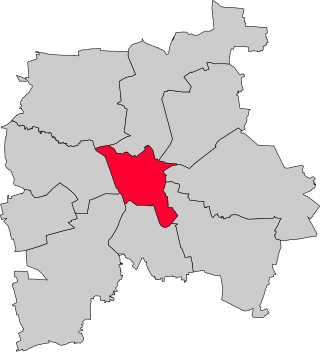
Leipzig-Mitte is one of ten boroughs (Stadtbezirke) of Leipzig, located in the center of the city. It includes numerous architectural monuments. Most of them are located in the subdivision "Zentrum", which is sited inside the Inner City Ring Road and the Promenadenring:

The Clara-Zetkin-Park is a park in Leipzig. From 1955 until 2011 it was Leipzig's largest park with an area of 125 hectares and was called Zentraler Kulturpark Clara Zetkin. The name was changed in 2011 and since then the Johannapark and the Palmengarten have officially been considered independent parks.

The Promenadenring Leipzig is the oldest municipal landscape park in Germany and one of the most important garden and cultural monuments in the city. The term is also used as a synonym for Leipzig's inner city ring road, a traffic facility that is connected to the green spaces of the Promenadenring. Like the inner city ring road, the promenade ring is about 3.6 kilometers long (2.24 mi.).
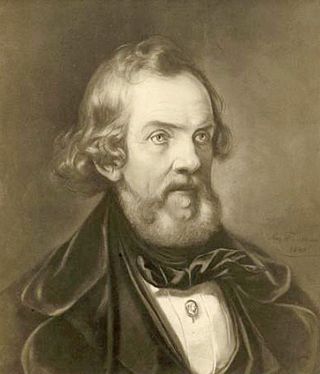
Christoph Wilhelm Leonhard Gerhard was a German merchant, playwright and poet.
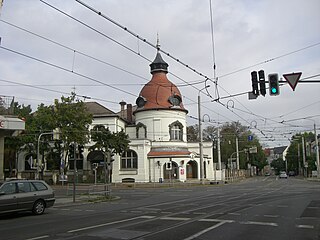
Karl-Heine-Strasse is a radial road in the west of Leipzig marking the boundary between the current boroughs of Leipzig-Plagwitz and Leipzig-Lindenau . 2.01 km (1.2 mi) long, it is named after the industrialist Karl Heine.

The Saxons' Bridge over the Elsterflutbett connects the eastern and western parts of Clara Zetkin Park in Leipzig, Germany. Located southwest of the city center, it also provides a car-free connection for pedestrians and cyclists from the center to the western part of Leipzig via Anton-Bruckner-Allee. According to the data from the 2021/22 traffic count, the Saxons' Bridge has the highest traffic occupancy with over 15,000 cyclists per day in cycling in Leipzig.


